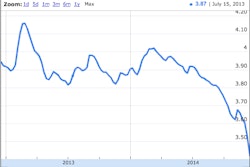Sometimes, what you might consider “old” is still very much “new” — a fact that applies to today’s used vehicle market. Case in point: the technology features found on the latest used trucks to enter the market.
Each year, as “new” model years of vehicles start to cycle through used vehicle market, they bring with them  features that were hot when initially built. This year, as a greater number of trucks manufactured around 2010 hit the secondary market, fleet managers are standing up and taking notice. The reason: many of these trucks come equipped with hot truck tech features that will still be touted in 2015.
features that were hot when initially built. This year, as a greater number of trucks manufactured around 2010 hit the secondary market, fleet managers are standing up and taking notice. The reason: many of these trucks come equipped with hot truck tech features that will still be touted in 2015.
With more buyers looking to snap up advanced features at used vehicle prices, here’s a look at current and upcoming features that are altering the trucking landscape.
Engine Tech
In 2010, the automotive trade press was on fire about improvements to truck engines taking place at the time. Back then, controversies raged about leftover issues from previous years, such as Exhaust Gas Recirculation (EGR) and variable-geometry turbochargers. For that reason, enhancements to a wide range of 2010 engines were being hailed for better fuel efficiency and performance.
Just how important were these enhancements? In OverDriveOnline.com’s article entitled “Some of the Best Engines Ever,” they write, “Just about all the engines for 2010 will be slightly different from the 2007 models — and better. In a world of truck diesels that have seen challenges with increasing maintenance and a drop in fuel economy with EGR, there will be some improvements in areas such as fuel economy and durability. This will happen in spite of the stringent new NOx standard.”
OverDriveOnline praised innovations like the common-rail fuel-injection system (and its variations) that injects a shot of fuel early in compression before full combustion happens. This action warms highly compressed engine air and reduces oxides of nitrogen (NOx), burning fuel more efficiently. These engines also run quieter.
Many of the 2010-era engines also boast greatly improved fuel pressure, even at low RPMs, said the publication. Simply put, “…heavy-duty diesels have a much larger fuel economy ‘sweet spot.’ This means less-skilled drivers who don’t shift at exactly the right time can still get good fuel economy.” These (and other) advancements to many 2010 engines are also known to contribute to longer engine life.
Telematics
It’s interesting to see how far things have come in just five years. For example, a look at recaps of the 2010 Detroit Telematics Conference reveal current tech trends that were already exploding. Hot topics on the 2010 agenda included:
- Wireless Systems – Onboard digital networks
- Fleet Tracking – Systems designed for remote monitoring and diagnostics
- Cloud Applications – Smartphone app integration
Considering that “connectivity” is the theme for the upcoming 2015 conference, one might conclude that the conversation hasn’t advanced very much.
But it has.
Telematics is a rising force in the commercial trucking industry right now. Whether these remote diagnostics and driver monitoring systems are built into new trucks, or retrofitted into used models, fleets everywhere are taking advantage of them.
How big is the impact? Consider the 2014 FleetBeat Report from Fleetmatics Group PLC, which analyzed data points from thousands of commercial fleets over five years to quantify telematics’ benefits.
The findings are striking. According to the reports, fleets using telematics over a five-year period achieved the following combined milestones:
- Decrease in fuel consumption (gallons per year): 573 million
- Total fuel savings: $2.2 billion
- Decrease in CO2 emissions (tons per year): 5 million
- Decrease in payroll hours per year: 1.3 billion
- Total cost savings due to decrease in payroll hours: $34.9 billion
Fleetmatics CEO and chairman Jim Travers said, “Saving $2.2 billion annually on fuel costs means putting a huge amount of money back into the tens-of-thousands of businesses using commercial telematics.”
The Future
Other hot tech on the horizon comes in the form of things like the long-awaited “autonomous” (that’s driverless) truck; predictive cruise control; and other applications of so-called “smart” truck maneuvering systems.
Software breakthroughs are enabling wonders like the dual-clutch automated manual transmission — the technology behind predictive cruise control. Automotive news website CJJDigital.com says this new software ties into GPS systems “…to accurately track and predict upcoming terrain features, then adjust gear selection and shift patterns as well as throttle input to manage them effectively.”
Along with innovations like next-generation GPS systems, and even new expanded TV antennas built for commercial truckers, the tech future is looking brighter every day — even for trucks built in the recent past.













